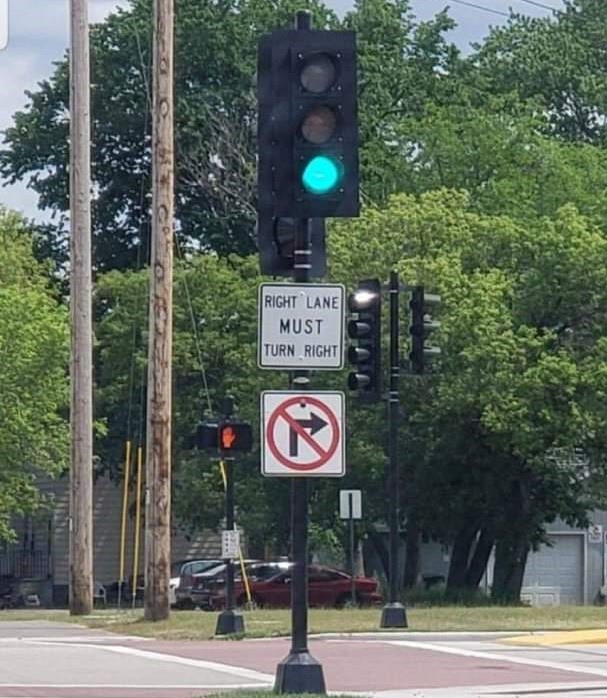
July Supps available here.
TSD Rally Home of the Pacific Northwest

July Supps available here.
I refined my trophy method for June, having learned much making ones for April May. The QC supervisor for the first event’s trophies was a beast. There are 18 trophies made for an event. (For seven cars? How’s that math work?) but it took about 50 (not kidding) to get 18 that I deemed acceptable.
June trophies were much better. Better color (painted yellow this time instead of dyed) and no alignment troubles. This time the squares were laser cut from a larger sheet after engraving, so alignment was guaranteed. The previous system was to engrave on a pre-cut square.
After two calibration samples of the June design, I plated the nine different class/place combinations and ran two copies of the plate. Some dark wood grain, voids in the plies, and a little bit of soot that I smudged during clean-up made for three QC rejects. I made a small plate for the three replacements. Yes, June was much better. There is one ‘feature’ used in May that I changed for June but plan to go back – the class/place is filled (solid) on May trophies and only a crisp outline on June’s. The outline looks good in person and in close-up pictures, but disappears when frame has more in it. Makes it impossible to see class/place in photos where winners are holding their awards.
Dash plaques were also much improved. They got painted this month, and also received the same clear finish of the trophies so there is little if any smoke odor.
Do you have an opinion on this trophy construction? Unless we reach attendance levels approaching 20 cars, there is little in the budget for trophies. The cost of materials to make these is low, and I think the end product looks pretty good.
I’m not thrilled with the dash plaques. Thin plywood (at least the type I bought) makes a poor dash plaque. I will explore other material options.
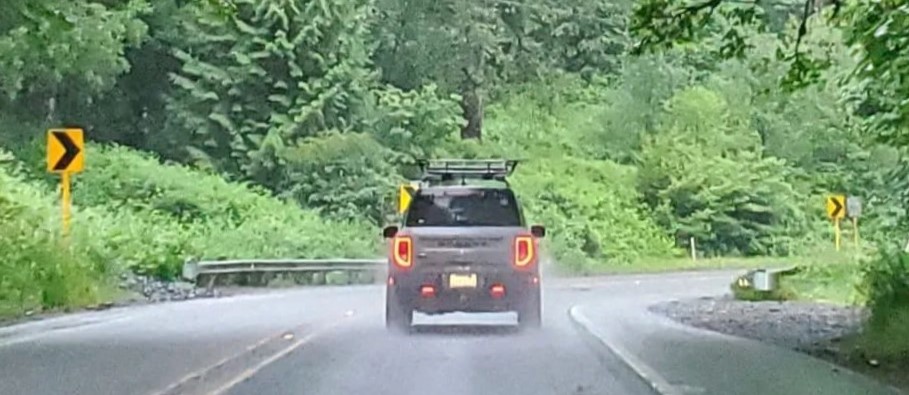
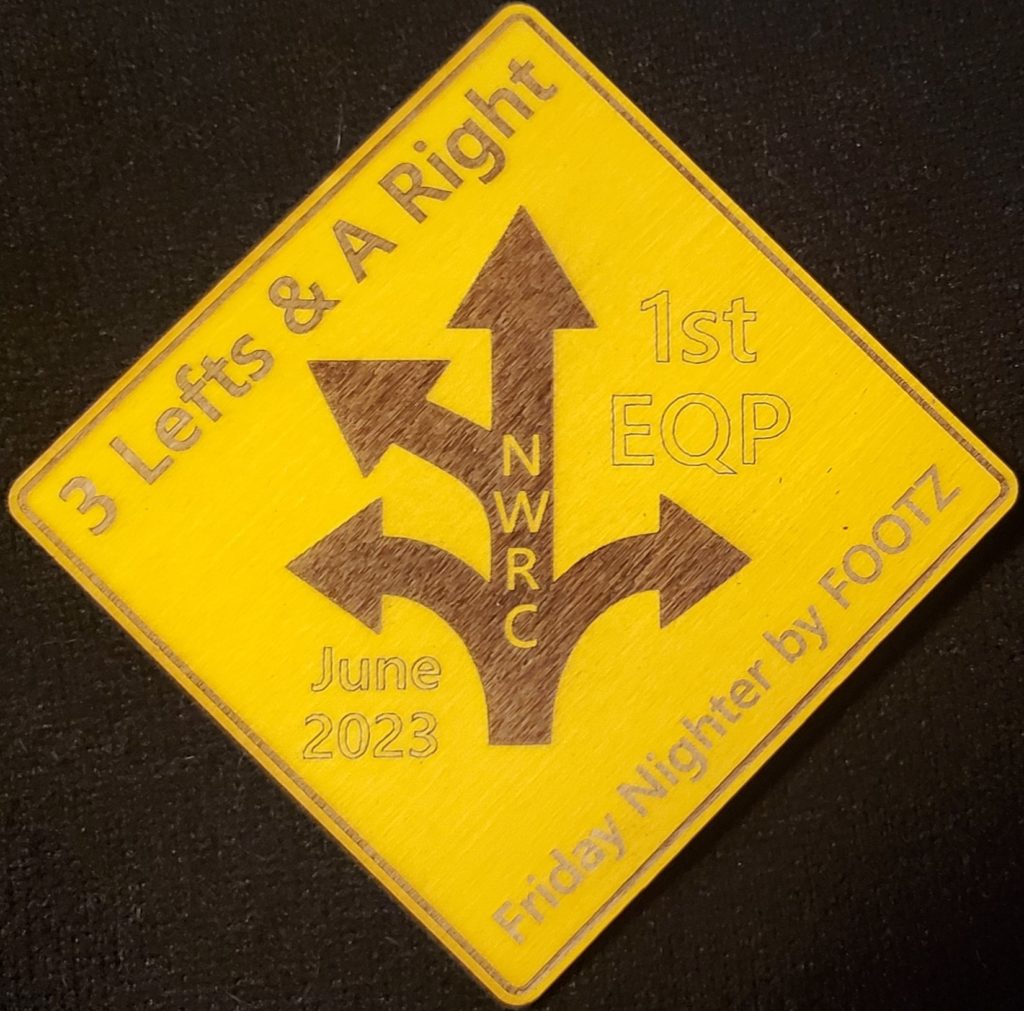
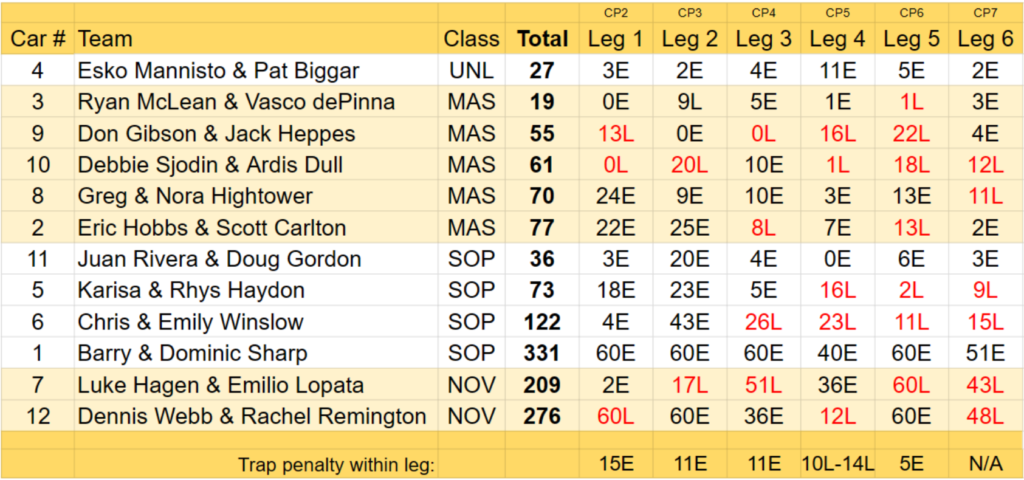
Despite a downturn in the weather bring drizzle the entire evening, twelve teams turned out for 3 Lefts & A Right, the June installment of the 2023 NWRC Friday Nighter Season.
FOOTZ delivered the second event using the Richta GPS Checkpoints system, lightly seasoned with time traps. All teams completed the route successfully. Once again, Farrelli’s Pizza in Maple Valley provided us will a good finish location.
A familiar odometer check led teams out to May Valley Road before competition began. Leg 1 went down Cedar Grove Road, then jogged over to Maxwell. Reaching a stop sign at a T, where NRI 21. L AT “STOP”, CAST 34 was available, the instruction could not be used as the route was forced left since the road to the right was a dead end. Teams using NRI 21 sped up, arriving at the checkpoint 15 seconds early.
Leg 2 cut east from Maxwell, skirted the edge of Hobart and passed local landmark The Yellow Submarine. While crossing the ridge before Ravensdale, teams executed a small speed change using NRI 30. CSD 2 AT [arrow] OR [deer]. This was the initial setup for the trap. The arrow sign comes up first and CSD at [arrow] is simple enough. There is a [deer] soon after, so even if the [arrow] was missed you move on to the next instruction. NRI 31. CAST 40 AT SECOND [arrow] OR [deer] seals your fate if done wrong. There is one more matching [arrow] and if treated as the second you’ll be 3 MPH faster (40 vs 37 here) for the rest of this leg. It was the first [arrow] encountered since executing the previous NRI. Good for 11 early at the checkpoint on the west side of Ravensdale Park.
The next leg used the pleasantly twisty Ravensdale-Black Diamond Road between its namesakes then headed out to the Green River Gorge. Along the way teams faced NRI 40. CAST 45 AT FOURTH PREMARKER OR PAUSE 9 AT “STOP”. A premarker is any of the many yellow, diamond-shape signs warning of something. Once outside of Black Diamond, there are two premarkers in quick succession. So far, so good. Then there is a long stretch of nothing. Eventually, two more appear on the horizon. They are still quite distant, but easy to see because they are the only things to spot. However, before you reach the third premarker, there is a stop sign on a gate in a wide turnout on the left. Amazing how the brain works, as that stop sign is hugely visible, but so hard to see once you’ve spotted those diamonds. The checkpoint was just before the GRG bridge. Using the first half of NRI 40 was good for 11 seconds early. 3rd & 4th premarkers are circled in red, below.

Leg 4 started just beyond the bridge, taking one of my favorite stretches of road up to Cumberland. On the way to Veazie, navigators became tense.
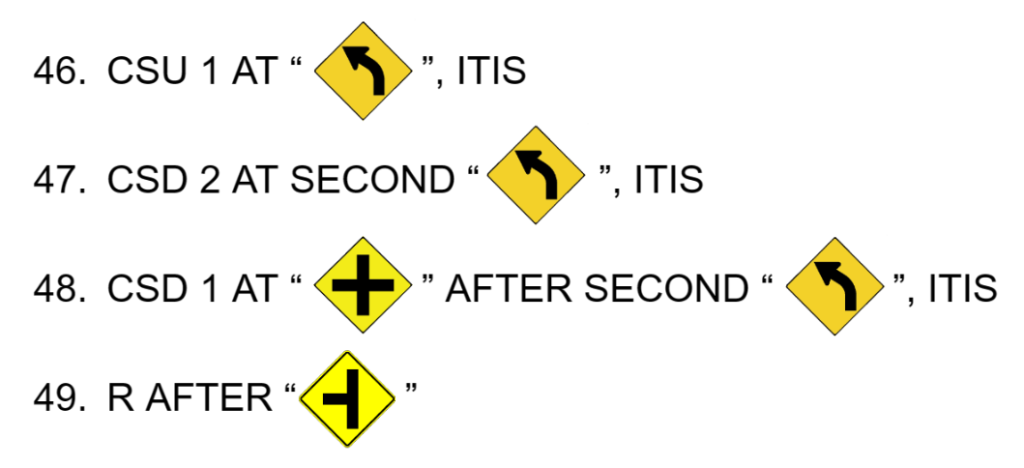
Stacking ITIS instructions is allowed, but frowned upon because it usually makes things very complicated. This stack only had shock value. It is much simpler than most stacked ITIS situations would be, as all of these ITIS instructions require finding the same [arrow] premarker. Although four NRIs are all on the table, you’re only looking for two things – that arrow and the sideroad sign. The first matching sign is the arrow, where NRI 46 is executed. Next comes another arrow. If you counted this sign as the 2nd and used NRI 47, that made you 11 early. Remember, it needed to be the 2nd after NRI 46. The crossroads premarker came next, but there had been no more arrows. If you executed NRI 48, add another 4 seconds early. Finally the sideroad premarker appeared and all that madness was behind you. Checkpoint just before Krain Korner.
Another short hop on SR169 and leg 5 started on SE 383rd. The phantom bantam was mentioned. NRI 53. CAST 34.4 AT JEMA RANCH RD ITIS (birthplace of famous rally rooster, Tatty) gave competitors a chance to forget that for this event, gravel roads did not exist. Cheap trap? Yes! I called it the chicken finger and kept the penalty small at 5 early. Otherwise, it was 5 miles of great road with nothing for the navigator to do except hang on. A right at stop brought you to the checkpoint just before Green Valley Road.
The final leg passed Flaming Geyser Park, then climbed the remarkably steep and twisty section of Green Valley. Hard to believe it still has a 40 speed limit. All the fun ends once GV reaches SR169 and the route heads to and through Black Diamond, then on to the last checkpoint about a mile before Four Corners.
Scoring was completed and awards presented as pizzas were coming out of the kitchen.
It was great to see the increase in turnout at this event. We had only seven cars in May. It takes more than six to cover the insurance cost, and at least ten with other expenses. The absence of Novice cars in May was alarming. One of the Novice teams this month came from Bellingham to check out the Richta system as they want to restart Chuckanut’s rally program. Perhaps the biggest surprise was the depth of the Master class, especially since one very consistent team was missing.
FOOTZ thanks: Bill and Charles Aggenbach for providing valuable feedback in the route/instructions checkout process. Charles also drove the pace car and assisted at the finish. Photo credit for the on-route image at the top of this post goes to Emily Winslow. The Winslows also spearhead the NWRC social media campaign. It takes a village.
See you all in July!
I’ve been pondering the universe more than usual in the last few days. And by that I mean I have poured over the Generals front and back looking for cracks in the foundation. Not to exploit, but to mend. I prefer to exploit solid rules. I was testing alternate interpretations against the June route instructions to see if it held up and avoided weak spots.
Some of the rules in the Generals are simple and clear. Some are confusing or lumpy. Lumpy? That’s a rule that almost did the job and then a problem was noticed so the cooks just dropped another word or two into the pot as a fix. That pot hasn’t been stirred since 2007. Yes, I was among those in the kitchen at the time.
I challenge you to read the first two sentences of section 4.1 and say the words “that is perfectly clear” in a believable manner.
4.1 A route instruction may have multiple actions and may also have multiple ACTION POINT(s). Execute each route instruction at its first possible ACTION POINT(s).
That looks pretty harmless. Multiple actions and ACTION POINTs are allowed, correct? Is it possible for a route instruction to have no action or ACTION POINT? Can the number of actions be different from the number of ACTION POINTs? I’ll suggest that the last question might be answered by the language used in the first sentence. I think that was probably the intent. If the action quantity was lockstep with the ACTION POINT count, the “may also have” would not be needed. Still wouldn’t be perfectly clear.
Route instructions are meant to be logical and readable (special terms and definitions aside). We can easily understand the instruction RIGHT AT SIGNAL PAUSE 30 and accept it as legitimate. It has two actions [RIGHT] and [PAUSE] doesn’t it? And they occur at the same ACTION POINT, so this may help answer the question of differing quantities and does so more clearly, if the example holds. If you want to raise your hand and ask about 4.5, you’re reading ahead in the Generals. Just back the truck up. We’ll get there soon enough. Until then, your punishment is to think about whether or not PAUSE is really an action. I assure you that its definition makes no convincing argument.
Which conveniently brings us back to the first question: can a route instruction have no action and/or ACTION POINT? Yes, and no. I have come to the understanding that the no action condition must be acceptable and yet there must be at least one ACTION POINT. To make things worse, the ACTION POINT can also be invisible, hypothetical, or fictional. You might hear people speak of an implied action. That is weak sauce. We use things like OBSERVE “NEXT EXIT” on almost every event. Sometimes it is just “NEXT EXIT”. Is there a need to imply OBSERVE? Is a lonely “NEXT EXIT” an executable instruction? I posit that it is fully compliant with 4.3.2. There is no change of direction specified but there is a REFERENCE, so the instruction should be executed AT the REFERENCE. The ACTION POINT is AT the REFERENCE, because 4.3.2 told us where to execute and 4.3 labels that an ACTION POINT. The only action that took place was the completion of the instruction. Woof. Invisible, hypothetical, and fictional ACTION POINTs are mentioned only to emphasize that while we’ve used 4.3 to identify the ACTION POINT(s) where execution actually took place, the definition in section 8 reads “can be…”
I’ll tear apart the second sentence of 4.1 in a future rant.
You, in the back having your 4.5 fit, wanted to ask how RIGHT AT SIGNAL PAUSE 30 is allowed when 4.5 reads
4.5 The same ACTION POINT will not be used simultaneously for two route instructions.
RIGHT and PAUSE are two actions (argument for another time) of the same route instruction, not two route instructions. This is an important distinction. It is part of the reason the first sentence of 4.1 specifically mentions multiple actions and ACTION POINTs. This example is considered two actions at a single ACTION POINT. I’ll let you stew over 6.7 for a bit.
I’ll end for now with a summary of how FOOTZ interprets the following instructions: